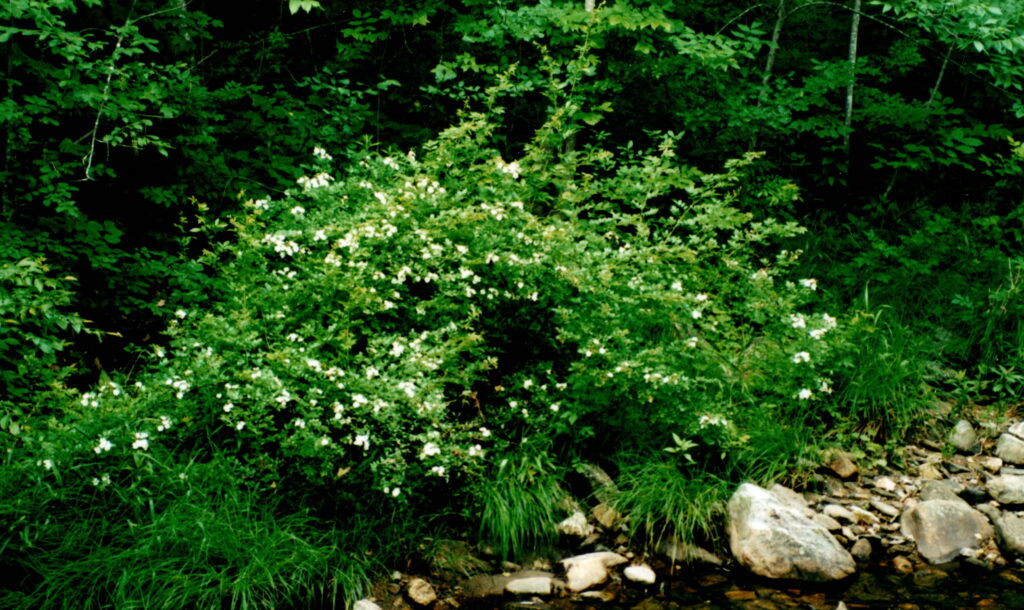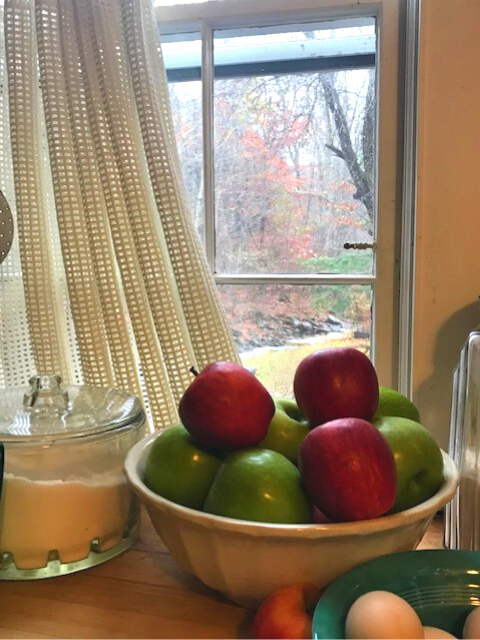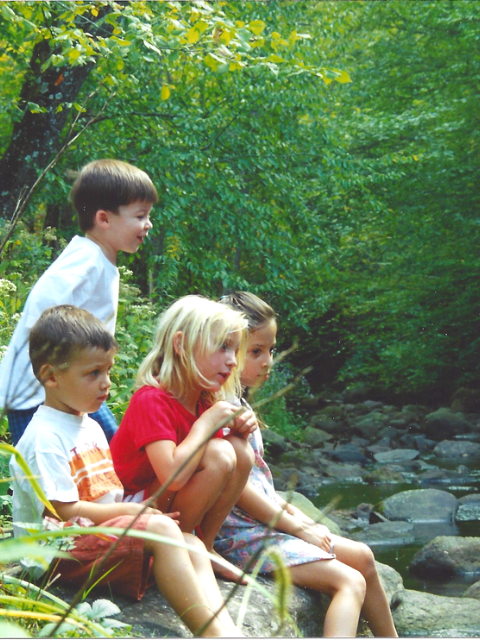Can one feeI the spirit of a house? Can a house be alive with feelings, empathy and caring? think so. Over 25 years ago we bought a house in the country that seemed to do just that. Our feelings are echoed by Mark Twain”s most beautiful words when he describes his house:
“To us, our house was not insentient matter – it had a heart, and a soul, and eyes to see us with; and approval and solicitudes, and deep sympathies; it was of us, and we were in its confidence, and lived in its grace and in the peace of its benediction. We never came home from an absence that its face did not light up and speak out its eloquent welcome – and we could not enter it unmoved.” -Mark Twain
Though the house is modest and unassuming on the outside, the inside is magical. One of the former owners cut out the inner walls in the back of the house, leaving an open plan. On all three sides of the house, one can see a river through over 20 wavy glass-paned windows. To my husband, the house flows like the water. Sometimes the mirrors collect the sun glistening on the river so there is a sparkle on the ceiling. Not one guest has left without commenting on the energy that old house exudes.
Up the street, the river parallels the road, but as it comes to our house, it almost hits it. Yet it then turns and runs along the back, a turn I call ”the angle of the meander,” which I will talk about later in the blog.
I can be standing by the kitchen window peeling apples for a pie, and I see the river coming towards the house before it turns at this angle to flow along the back side.

When we sit in the dining area, we can see the water on two sides as it flows along this angle, giving us the illusion of living on a houseboat. At night, we sleep to the sound of a babbling brook and the fragrance of wildflowers that grow along the bank.
The House’s Shadow Side
Although the house gave us great joy, we had issues with owning such an old structure. My husband once showed me a cartoon in the October 22, 2019 issue of the New Yorker and asked me if this was not us. New Yorker
We didn’t buy our rural home because we were bored but had a desire for closeness to the earth. Still, we did run into a multitude of problems just like the couple in the cartoon anticipated.
We ignored the tilting chimney until it started to resemble the leaning tower of Pisa five years later. Our fireplace had to be replaced in the midst of constant repairs: we got a new roof, replaced rotting decks, redid the leach field, and got stuck in the middle of a mouse and carpenter ant war. The well was contaminated with road salt, which corroded our appliances consistently. Once, the corrosion broke a kitchen pipe. When we were away, days of running water ruined a new linoleum floor, the sub-floor beneath and the heater fan. Because both of us were teachers, there were never tons of money in the bank account. Each repair was a loan off our pension or tightened belts for that year.
To add to the problems, we became aware that the house side of the riverbank was eroding. Our grandchildren visiting the first summer loved sitting on the “big rock” that made up the bank. The following year, as my husband was standing on the same rock, it gave way under his feet. We knew then that things were happening.
The four children sitting on a 200 pound flat rock that formed the riverbank. The following year it would break away.
The Spirit of the House
Compounding the constant repairs from owning an old house, it seemed as if the house repeatedly acts out if we left it for extended time periods. A two week hiatus in New York City would end in a broken pipe, a failed appliance or a pump problem when we returned. Like a canine, it seemed our house misbehaved when it doesn’t have people to give it love and attention. Long lasting fruits and vegetables like apples and onions, which would keep for months in the refrigerator, started to rot as soon as we left the house alone. My husband, a scientist, does not believe in animism. So, I was quite surprised when we returned from a short absence to find the dishwasher broken. “I think this house is alive!” he exclaimed that day. Smiling inside, I had always known that.
The Spirit of the House and the Forces of Nature and Us
I do believe in animism and trust that the house made an agreement with the owners’ souls to love and protect them, though it expected love and care in return. As time went on, an even more bizarre realization dawned. Crazy as it sounds, I believe the house had also made an agreement with the forces of nature.
I have many examples. My first clue to this possibility came when, one day, the 150-year-old oak near the house threw off a huge, two-forked branch that could have leveled the house. One fork landed in the whole front of the house and ripped off the well cover, sending a large pot of pansies into its depths. The other fork hugged the side, destroying a stone retaining wall. Small branches, like the arrows of Zeus, were thrust into the ground, one of which severed the gray water pipe that connected with the septic. The house, on the other hand, did not get a scratch.
A former owner confirmed my suspicions when she told me that the house always seemed to save itself. She recalled the Flood of ’55 when two back-to-back hurricanes, Connie and Diane, saturated the area. Little streams and rivers engorged by 20 inches of rain became raging torrents. Houses in a neighboring community broke loose and floated to their destruction on these newly formed rapids. Still, for some reason, our house was spared due to a huge beech tree that came floating down the river, wedging itself in the trees behind the house. The tree created a protective wall between the river and the house, and even though the road and topsoil for miles around had washed away, the house stayed intact.
Testing My Beliefs of Animism
In 2011, Hurricane Irene hit the area. During the storm, the river came into the basement and covered our furnace, washer, dryer and freezer with mud. It eroded the riverbank at the angle until only two inches of land lay between the deck and the river. Although we had evacuated, the volunteer firefighter on the scene at the time told me the house was surrounded by Category 5 waves on all three sides. The water made it halfway up the back steps to the living room door, which made him fear the house was going to break apart and float down the river.
After the flood, I dusted off my PTSD and worked with my husband to clean out the mud and fix the appliances. We were able to repair, stabilize and strengthen the eroded bank thanks to FEMA and the Massachusetts Conservation Committee. The huge expense was ours, however, and no pension loan would cover it, so we took out a home equity loan to repair the home we loved.
The Angle of the Meander
Eight years later, The Berkshire Planning Commission of Massachusetts created the Community Resilience Building Workshop to help small wetland communities address the impact of global warming. After we were contacted due to our property damage, I replied, “It is not if we are going to lose the house, it is when…” I then said it was “the damned angle of the meander that causes all the problems,” fixable but costly. The concern I expressed to the commission was even costlier. If our house did break apart in a hurricane, it could become a dam and further flood the valley below, adding broken house toxins like oil, propane, lead and formaldehyde to the river that flows into a reservoir and supplies the drinking water to Hartford, Connecticut. “Why don’t they just fix it?” my pen cried out.
What is a Meander

Rivers change and grow. Young rivers flow in a straight line. Ours is not Old Man River but is probably prepubescent, struggling to mature. Waters in rivers run at different velocities. The part with a greater speed erodes the bank and then deposits the sediment further down on the opposite side, which causes a river to start curving. We don’t have a curve yet; just an angle. As more erosion occurs, the velocity of the water increases, causing further erosion. Sometimes the curve breaks away and forms an oxbow lake or more often the curve remains and becomes a flood plain. Rivers also move due to this erosion. A hundred and fifty years ago, our river was further away from the house, but now it is moving closer to us and the road.
This phenomenon is a common problem that many communities experience—young changing rivers challenge bridges, roads and properties. For years, people dealt with our angle of the meander with brute physical efforts, replacing rocks at the angle, often getting them from the other side. They sometimes added boulders. All these efforts worked for a while, changing the flow of the river, but in a heavy storm, one could hear the boulders crashing down stream. Before the Wetlands Protection Act of 1972, heavy machinery was used. Today, the erosion can be seen in the underbelly of the road upstream. The truth is the river wants to be our road, and if it gets its way, it will get our house.
Believing in My Beliefs
I am writing this blog in 2020 when we are seeing the effects of climate change throughout the planet. In June, we heard there were 32 possible storms that could become hurricanes. Which one will become the one to fear? Still, we are resigned to potential loss. I know for sure we will be cleaning mud out of the basement again. After all, New York’s Governor Cuomo said that the storm of the century now occurs every two years.
So I am now at a point where I am pulled by fear of climate change with a belief that our beloved house will stay. I also know that things do not last forever. The house may decide when it has to go. In the meantime, however, I will bask in its warmth and beauty. We talk to it, tell it we love it, and always say goodbye when we leave. We ask it to protect itself as it has done with all its inhabitants. The house envelops us with its warmth and beauty, and we are uplifted by the energy it gives us.



Leave a Reply